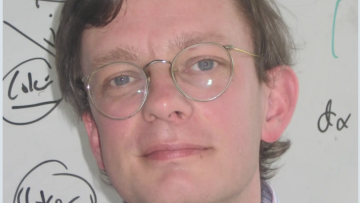Optimizing the Campos-Griffiths-Morris-Sahasrabudhe upper bound on Ramsey numbers
Part of the Oxford Discrete Maths and Probability Seminar, held via Zoom. Please see the seminar website for details.
Abstract
In a recent breakthrough Campos, Griffiths, Morris and Sahasrabudhe obtained the first exponential improvement of the upper bound on the classical Ramsey numbers since 1935. I will outline a reinterpretation of their proof, replacing the underlying book algorithm with a simple inductive statement. In particular, I will present a complete proof of an improved upper bound on the off-diagonal Ramsey numbers and describe the main steps involved in improving their upper bound for the diagonal Ramsey numbers to $R(k,k)\le(3.8)^k$ for sufficiently large $k$.
Based on joint work with Parth Gupta, Ndiame Ndiaye, and Louis Wei.
Boundedness of discounted tree sums
Part of the Oxford Discrete Maths and Probability Seminar, held via Zoom. Please see the seminar website for details.
Abstract
Let $(V(u))$ be a branching random walk and $(\eta(u))$ be i.i.d marks on the vertices. To each path $\xi$ of the tree, we associate the discounted sum $D(\xi)$ which is the sum of the $\exp(V(u))\eta_u$ along the path. We study conditions under which $\sup_\xi D(\xi)$ is finite, answering an open question of Aldous and Bandyopadhyay. We will see that this problem is related to the study of the local time process of the branching random walk along a path. It is a joint work with Yueyun Hu and Zhan Shi.
On forbidden configurations in point-line incidence graphs
Abstract
The celebrated Szemeredi-Trotter theorem states that the maximum number of incidences between $n$ points and $n$ lines in the plane is $\mathcal{O}(n^{4/3})$, which is asymptotically tight.
Solymosi conjectured that this bound drops to $o(n^{4/3})$ if we exclude subconfigurations isomorphic to any fixed point-line configuration. We describe a construction disproving this conjecture. On the other hand, we prove new upper bounds on the number of incidences for configurations that avoid certain subconfigurations. Joint work with Martin Balko.
16:00
Approximating Primes
Abstract
A successful strategy to handle problems involving primes is to approximate them by a more 'simple' function. Two aspects need to be balanced. On the one hand, the approximant should be simple enough so that the considered problem can be solved for it. On the other hand, it needs to be close enough to the primes in order to make it an admissible to replacement. In this talk I will present how one can construct general approximants in the context of the Circle Method and will use this to give a different perspective on Goldbach type applications.
12:00
Combinatorial proof of a Non-Renormalization theorem
Abstract
In "Higher Operations in Perturbation Theory", Gaiotto, Kulp, and Wu discussed Feynman integrals that control certain deformations in quantum field theory. The corresponding integrands are differential forms in Schwinger parameters. Specifically, the integrand $\alpha$ is associated to a single topological direction of the theory.
I will show how the combinatorial properties of graph polynomials lead to a relatively simple, explicit formula for $\alpha$, that can be evaluated quickly with a computer. This is interesting for two reasons. Firstly, knowing the explicit formula leads to an elementary proof of the fact that $\alpha$ squares to zero, which asserts the absence of quantum corrections in topological field theories of two (or more) dimensions, known as Kontsevich's formality theorem. Secondly, the underlying constructions and proofs are not intrinsically limited to topological theories. In this sense, they serve as a particularly instructive example for simplifications that can occur in Feynman integrals with numerators.



